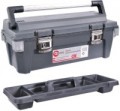Suitable for
The type of tool for which the container is normally intended.
—
For hand tools. Products intended primarily for hand tools - hammers, screwdrivers, pliers, etc. Such tools are relatively small in size and, most often, of a standard shape; so for such boxes there is no point in specifying compatibility (see below). Note that such products are not suitable for small items - so if you plan to work with a large amount of “small things”, it is worth finding a container that was originally designed for this (see below).
—
For tools and small items. Containers designed for both hand tools (see above) and for storing a large number of small parts. The specific design of such products may vary. Thus, in classic boxes (see “Type”), a cover with an organizer is most often provided for small items (see below); individual organizers for this purpose have compartments of different sizes; Vests and belt bags differ in size, respectively, pockets, etc.
—
Only for small elements. Containers intended only for small parts - fasteners (bolts, nuts, screws, nails), some types of working attachments (drills, bits), etc. The vast majority of such containers are classified as organizers (see “Type”), although there are and exceptions.
—
For power tools. Containers for this purpose are characterized by a high degree of
...specialization; they are usually made for specific models of power tools (see “Compatibility”). This is due to the fact that similar instruments (even of similar purpose and level) differ markedly in the general structure and arrangement of various structural elements. And even if compatibility for such a container is not indicated, most likely it is intended at least for equipment from a certain brand.Size
The main size of the container for tools. Inches are traditionally used for this designation, and the length is usually indicated as the main size. This information allows you to evaluate the "weight category" of the product as a whole, as well as to determine whether it is suitable for a particular instrument of large sizes. At the same time, the characteristics usually indicate the overall dimensions on all three main sides (in millimetres), however, it is more convenient for many craftsmen to use the size designation in inches.
For kits (see below), this paragraph indicates the dimensions of all containers supplied in the kit.
Lid organizer
Availability
of a built-in organizer in the lid of the tool container.
The features of organizers are described in detail in paragraph “Type”; this type differs only in that it is built into the lid, and not made as a separate device. The combination of a box or case with an organizer allows you to conveniently store both large tools and small items such as fasteners or replaceable attachments in one container: the main volume is well suited for the former, the latter is convenient to keep in small cells of the organizer.
Organizer slots
The number of individual cells provided in the organizer. In this case, we can talk about an organizer as a separate device (see "Type"), or a set of cells built into the lid of the box (see "Lid with an organizer"). And for solutions with removable partitions, in which cells can be combined, the maximum number is indicated — with all installed partitions.
Organizers, by definition, are designed mainly for small things. Therefore, the more cells there are, the more varieties of small items can be stored in a container. For example, in 10 cells you can keep bolts of five different sizes and separately nuts for them. Such a number of compartments —
up to 10 — is generally considered small, but in fact it is often quite enough.
11 – 20 cells can be called an average, and the most capacious organizers have
up to 30 compartments. However it is worth considering that with the same dimensions of the container, an increase in the number of cells leads to a decrease in their volume.

